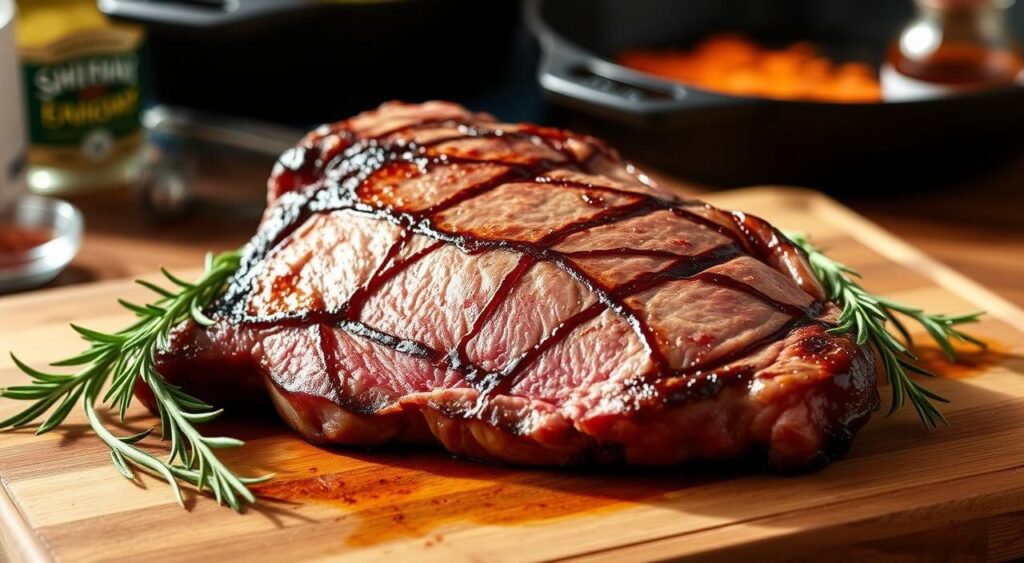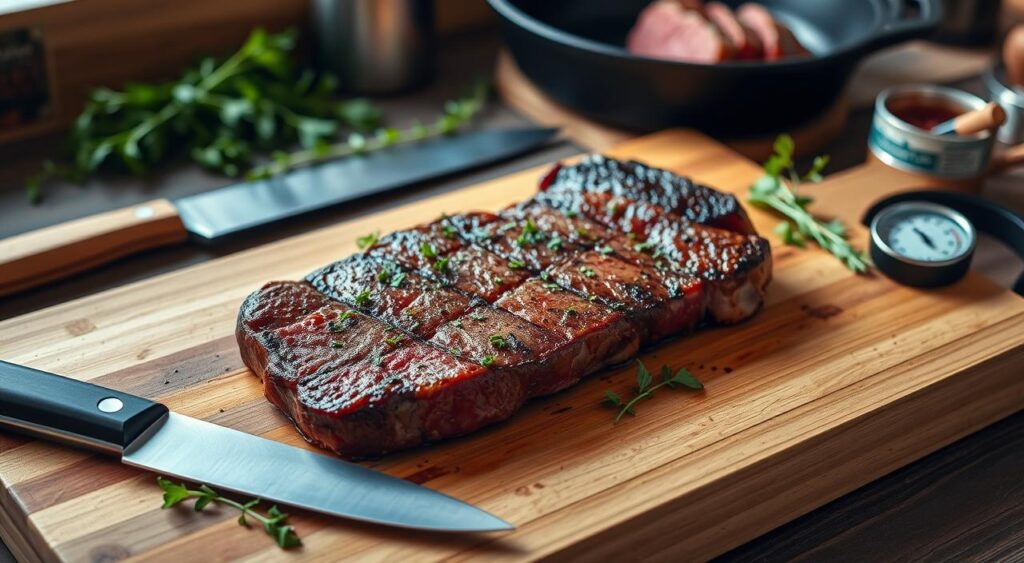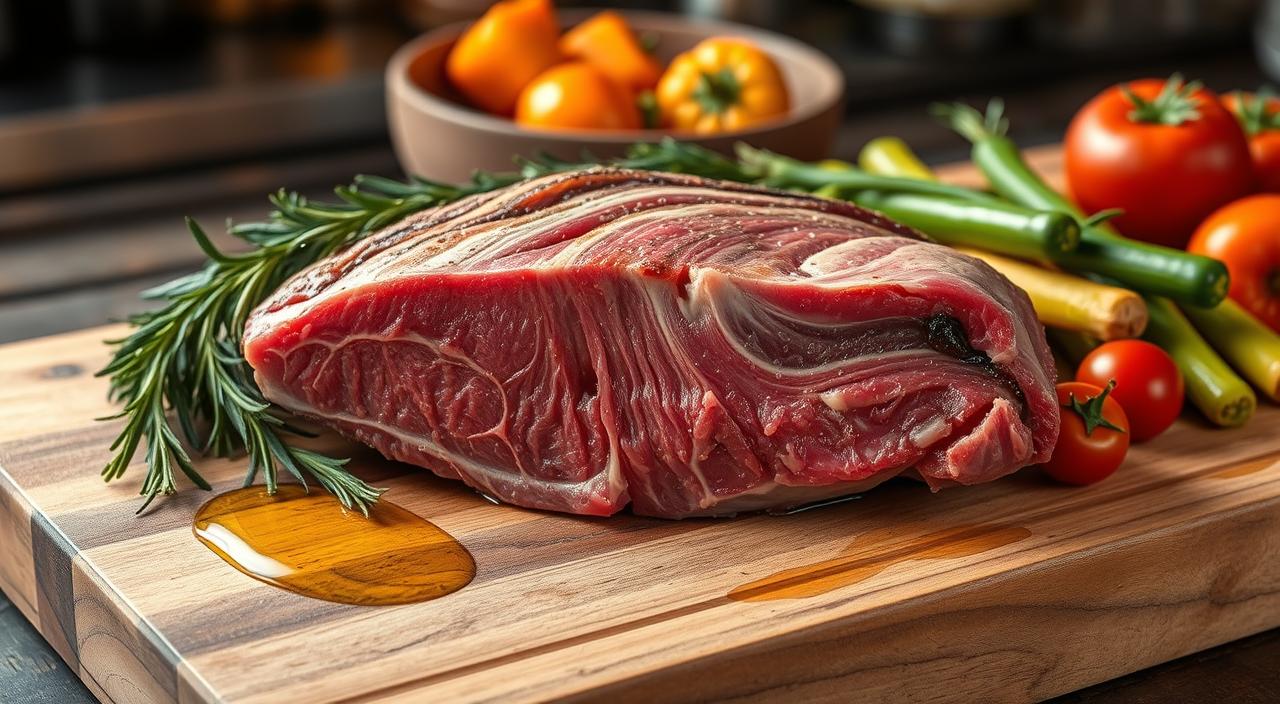I’ve always been drawn to hanger meat, often called the ‘butcher’s tenderloin.’ It’s a secret favorite among chefs. Today, I’ll share the secrets to cooking it like a pro.
Hanger steak is tender and full of beefy flavor. It’s a small cut, but finding it is worth it. With the right cooking, it can make any meal special.
Understanding the Butcher’s Best-Kept Secret: What is Hanger Meat

Many home chefs don’t know about the onglet, or hanger steak. It’s a hidden gem often ignored. This cut, also known as the “butcher’s tenderloin,” is a small but powerful muscle. It hangs from the cow’s diaphragm, connecting it to the trailing rib.
Why It’s Called the Butcher’s Tenderloin
The hanger steak, or hanging tenderloin, is a favorite among butchers. They often keep it for themselves or their most loyal customers. This cut is well-marbled, with a coarse grain. It’s perfect for marinades, offering a beefy flavor like a ribeye with a nutty undertone.
Location and Characteristics of the Cut
Hanger steak is a single muscle, weighing between 8 to 16 ounces. It’s a small but powerful cut. Its unique location and characteristics make it tender when sliced against the grain, offering a unique eating experience.
Flavor Profile and Texture
The bistro steak is famous for its strong, beefy flavor and tender texture. Its well-marbled composition and coarse grain give it a unique mouthfeel. This makes it a favorite among those who know about it.
Essential Tools and Equipment for Perfect Hanger Steak Preparation

To make a tender and flavorful butcher’s steak or French hanger steak, you need the right tools. A sharp knife is key for removing the central membrane and butterflying the meat. A food processor helps in making marinades that tenderize and flavor your steak.
For grilling, a charcoal Weber grill with chimney starters is great. It provides high heat for searing the steak’s exterior while keeping it juicy inside. A Thermapen meat thermometer is crucial for cooking the steak to the perfect temperature.
You’ll also need a shallow dish for marinating and a sturdy cutting board for resting and slicing the steak. With these tools and some preparation, you can cook a delicious butcher’s steak or French hanger steak at home.
“Hanger steak is sometimes called the ‘inner tenderloin’ of the cow, and it’s one of the most affordable and flavorful cuts of beef.”
Preparing Your Hanger Steak Before Cooking
Hanger meat, also known as beef hanger steak, is a flavorful and tender cut. It needs special attention before cooking. Take the time to prepare your hanger steak for the best results.
Removing the Central Membrane
The first step is to remove the central membrane. This membrane runs through the hanger meat. Use a sharp, long knife to slice along the steak’s length.
Some butchers may have already done this for you. But it’s good to check before cooking.
Proper Butterflying Technique
Next, consider butterflying your hanger steak. Cut it horizontally, almost all the way through. Then, open it up like a book.
Butterflying helps the steak cook evenly and quickly. This ensures a tender and juicy result.
Temperature Considerations
For the best flavor and texture, let your hanger steak come to room temperature. This usually takes about 30 minutes. Room temperature helps the meat cook more evenly.
This results in a more tender and juicy final product.
With these simple steps, you’re ready to enjoy a delicious hanger steak cooked to perfection.
The Art of Marinating Bistro Steak
Marinating is key to making your bistro steak taste amazing. This cut is known for its strong flavor. With the right marinade, it can become a true culinary delight. Our research shows the bistro steak recipe gets a 4.91 rating from 98 votes, and it takes just under 5 hours to prepare.
For top-notch results, marinate your steak for at least 4 hours. Mix garlic, thyme, olive oil, and a bit of Worcestershire sauce for the marinade. This mix tenderizes the meat and adds a rich flavor that everyone will love.
“The marinade is the secret to unlocking the full potential of this flavorful cut,” says our culinary expert. “Be sure to wipe off any excess before grilling to prevent burning, and you’ll be rewarded with a steak that’s bursting with flavor in every bite.”
Patience is crucial when marinating. The longer the steak soaks, the stronger the flavor. This recipe serves 4, so you can impress your loved ones with your new skill.
Mastering the Perfect Seasoning Blend
Preparing the perfect butcher’s tenderloin or French hanger steak starts with seasoning. Seasoning boosts the meat’s natural flavors and creates a delicious crust when seared.
Salt and Timing
Seasoning hanger meat like a pro is all about timing. Sprinkle kosher salt on your steak right before cooking. This pulls out moisture, leading to a better sear and flavor.
Don’t season too early, as it can dry out the meat.
Herb and Spice Combinations
There are many herb and spice mixes to match hanger steak‘s richness. A mix of garlic, thyme, and black pepper offers a classic taste. Or, try bold spices like smoked paprika or cayenne for something different.
The goal is to highlight the meat’s natural qualities without overwhelming its juices and tenderness.
Charcoal vs. Gas Grilling Methods
Grilling your hanging tenderloin, also known as the underrated cut, can be done with charcoal or gas grills. Both methods can make your steak taste amazing. It really depends on what flavor you want and what you like better.
Charcoal grilling gives your hanger steak a smoky taste. This is because of the charcoal briquettes. It also helps create a caramelized crust that keeps the meat juicy. To use charcoal, light two chimney starters and let them burn for 30 minutes before cooking.
Gas grilling, on the other hand, lets you control the heat easily. You can adjust it with just a knob. Gas grills also cook evenly, making sure your steak is perfect all over.
“Whether you opt for charcoal or gas, the key to unlocking the true potential of your underrated cut lies in preheating the grill to high heat before cooking.”
It doesn’t matter if you use charcoal or gas. The most important thing is to preheat the grill well before cooking. This step is crucial for searing the meat and keeping it juicy. It makes your meal truly special.
Temperature Control and Cooking Times for Optimal Results
Getting the perfect doneness for your onglet, or butcher’s steak, is key. It makes the steak tender and flavorful. Focus on temperature control and cooking times for a top-notch result.
Rare to Medium Doneness Guide
Hanger steak is best cooked to medium, around 135°F (57°C). This softens the tough fibers and makes it tender. For a rare steak, aim for 125°F (52°C). Always use a meat thermometer for accurate readings.
Using a Meat Thermometer
A good meat thermometer is crucial for cooking the perfect onglet. Stick the thermometer into the thickest part, avoiding bones. Watch the temperature closely. Remove the steak when it’s 5°F (3°C) below your desired doneness. The temperature will rise a bit during rest.
“The key to juicy, tender hanger steak is to cook it to medium doneness and let it rest before slicing.”
Cooking times depend on the steak’s thickness. Grill for 2-3 minutes per side for rare, and 4-5 minutes for medium. Always let the steak rest for 5-10 minutes. This allows the juices to spread evenly.
Professional Tips for Achieving Restaurant-Quality Results
To make your hanger meat into a steak fit for a pro kitchen, follow these tips. First, make sure your grill or cooking surface is very hot before adding the beef hanger steak. This high heat creates a tasty crust and keeps the beefy flavors inside.
Don’t flip or move the steak too much while it’s cooking. Let it sear for 3-4 minutes on each side to get it just right. After cooking, let the steak rest for 10 minutes before slicing. This step makes the meat tender and juicy.
When you’re ready to serve, slice the steak against the grain. This makes it even more tender and enjoyable to eat. With these tips, you can make a top-quality steak at home, just like a fancy steakhouse.
FAQ about hanger meat
What is hanger steak and why is it called the “butcher’s tenderloin”?
Hanger steak is a tender cut from the cow’s diaphragm. It’s prized for its flavor and tenderness. Butchers and chefs love it, earning it the nickname “butcher’s tenderloin”.
Where does hanger steak come from and what are its characteristics?
Hanger steak is from the cow’s lower belly or plate. It’s a single muscle that hangs from the cow’s rib. It’s well-marbled and coarse-grained, perfect for marinades.
The flavor is beefy, like a ribeye, with a nutty taste.
What are the essential tools and equipment needed to prepare hanger steak?
You’ll need a sharp knife for removing the membrane and butterflying. A food processor is great for marinades. A meat thermometer, like a Thermapen, ensures accurate temperatures.
For grilling, a charcoal Weber grill with chimney starters is best.
How do you prepare hanger steak before cooking?
Start by removing the central membrane with a sharp knife. Then, butterfly the remaining loins for even cooking. Let the meat warm up to room temperature before cooking.
How does marinating hanger steak enhance its flavor and tenderness?
Marinating hanger steak boosts its flavor and tenderness. Use a mix of garlic, thyme, olive oil, and Worcestershire sauce. Marinate for at least an hour for deeper flavor.
How should hanger steak be seasoned for the best results?
Season the steak with salt just before cooking to keep moisture in. Add pepper if you like, but some chefs skip it to avoid burning. Herbs like garlic and thyme enhance the meat’s natural taste.
What are the pros and cons of charcoal and gas grilling for hanger steak?
Both charcoal and gas grilling are good for hanger steak. Charcoal adds smoky flavor and allows for high-heat searing. Gas grilling offers better temperature control and ease.
What’s the ideal doneness and cooking time for hanger steak?
Cook hanger steak to medium doneness (135°F) for tenderness. Cooking times vary by thickness. Grill for 2-3 minutes per side for rare, and 4-5 minutes for medium.
What are some professional tips for achieving restaurant-quality hanger steak?
For top-notch results, heat your grill extremely before cooking. Sear the steak quickly on both sides for a flavorful crust. Don’t move the steak much while cooking.
Let the meat rest for 10 minutes before slicing against the grain for tenderness.
